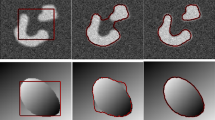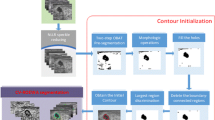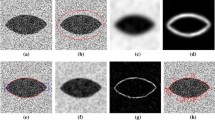Abstract
Segmenting the lesion regions from the ultrasound (US) images is an important step in the intra-operative planning of some computer-aided therapies. High-Intensity Focused Ultrasound (HIFU), as a popular computer-aided therapy, has been widely used in the treatment of uterine fibroids. However, such segmentation in HIFU remains challenge for two reasons: (1) the blurry or missing boundaries of lesion regions in the HIFU images and (2) the deformation of uterine fibroids caused by the patient’s breathing or an external force during the US imaging process, which can lead to complex shapes of lesion regions. These factors have prevented classical active contour-based segmentation methods from yielding desired results for uterine fibroids in US images. In this paper, a novel active contour-based segmentation method is proposed, which utilizes the correlation information of target shapes among a sequence of images as prior knowledge to aid the existing active contour method. This prior knowledge can be interpreted as a unsupervised clustering of shapes prior modeling. Meanwhile, it is also proved that the shapes correlation has the low-rank property in a linear space, and the theory of matrix recovery is used as an effective tool to impose the proposed prior on an existing active contour model. Finally, an accurate method is developed to solve the proposed model by using the Augmented Lagrange Multiplier (ALM). Experimental results from both synthetic and clinical uterine fibroids US image sequences demonstrate that the proposed method can consistently improve the performance of active contour models and increase the robustness against missing or misleading boundaries, and can greatly improve the efficiency of HIFU therapy.
Similar content being viewed by others
References
S Ali, A Madabhushi. An integrated region-, boundary-, shape-based active contour for multiple object overlap resolution in histological imagery, IEEE Trans Med Imaging, 2012, 31(7): 1448–1460.
D P Bertsekas. Constrained Optimization and Lagrange Multiplier Methods, In: Computer Science and Applied Mathematics, Academic Press, Boston, 1982.
A Blake, M Isard. Active Contours: the application of techniques from graphics, vision, control theory and statistics to visual tracking of shapes in motion, Springer, London, 2000.
X T Cai, F Z He, W D Li, X X Li, and Y Q Wu. Encryption based partial sharing of cad models, Integr Comput-Aid E, 2015, 22(3): 243–260.
E J Candès, X D Li, Y Ma, and J Wright. Robust principal component analysis? J ACM, 2001, 58(3): 11.
E J Candès, B Recht. Exact matrix completion via convex optimization, Found Comput Math, 2009, 9(6): 717–772.
V Caselles, R Kimmel, and G Sapiro. Geodesic active contours, Int J Comput Vision, 1997, 22(1): 61–79.
A H Chan, V Y Fujimoto, D E Moore, R W Martin, and S Vaezy. An image-guided high intensity focused ultrasound device for uterine fibroids treatment, Med Phys, 2002, 29(11): 2611–2620.
T F Chan, L A Vese. Active contours without edges, IEEE Trans Image Process 2001, 10(2): 266–277.
T Chan, W Zhu. Level set based shape prior segmentation, In: IEEE Comput Soc Conf CVPR 2005, 2005, 2: 1164–1170.
Y M Chen, H D Tagare, S Thiruvenkadam, F Huang, D Wilson, K S Gopinath, R W Briggs, and E A Geiser. Using prior shapes in geometric active contours in a variational framework, Int J Comput Vision, 2002, 50(3): 315–328.
Y Cheng, F Z He, X T Cai, and D J Zhang. A group undo/redo method in 3d collaborative modeling systems with performance evaluation, J Netw Comput Appl, 2013, 36(6): 1512–1522.
T F Cootes, C J Taylor, D H Cooper, and J Graham. Active shape models-their training and application, Comput Vis Image Und, 1995, 61(1): 38–59.
D Cremers, M Rousson, and R Deriche. A review of statistical approaches to level set segmentation: integrating color, texture, motion and shape, Int J Comput Vision, 2007, 72(2): 195–215.
C Dharmagunawardhana, S Mahmoodi, M Bennett, and N Mahesan. Unsupervised texture segmentation using active contours and local distributions of gaussian markov random field parameters, Proc British Mach Vision Conf, 2012, pp 88.1–11.
M Fazel. Matrix rank minimization with applications, PhD thesis, Stanford University, 2002.
F Z He, S H Han. A method and tool for human-human interaction and instant collaboration in cscw-based cad, Comput Ind, 2006, 57(8): 740–751.
R A Horn, C R Johnson. Matrix Analysis, Cambridge University Press, 2012.
Z Y Huang, F Z He, X T Cai, Z Q Zou, J Liu, M M Liang, and X Chen. Efficient random saliency map detection, Sci China Ser F, 2011, 54(6): 1207–1217.
S X Jing, F Z He, S H Han, X T Cai, and H J Liu. A method for topological entity correspondence in a replicated collaborative cad system, Comput Ind, 2009, 60(7): 467–475.
M Kass, A Witkin, and D Terzopoulos. Snakes: Active contour models, Int J Comput Vision, 1988, 1(4): 321–331.
F Lecellier, J Fadili, S Jehan-Besson, G Aubert, M Revenu, and E Saloux. Region-based active contours with exponential family observations, J Math Imaging Vision, 2010, 36(1): 28–45.
C M Li, R Huang, Z H Ding, J C Gatenby, D N Metaxas, and J C Gore. A level set method for image segmentation in the presence of intensity inhomogeneities with application to mri, IEEE Trans Image Process, 2011, 20(7): 2007–2016.
C M Li, C Y Xu, C F Gui, and M D Fox. Distance regularized level set evolution and its application to image segmentation, IEEE Trans Image Process, 2010, 19(12): 3243–3254.
X X Li, F Z He, X T Cai, D J Zhang, and Y L Chen. A method for topological entity matching in the integration of heterogeneous cad systems, Integr Comput-Aid E, 2013, 20(1): 15–30.
H J Liu, F Z He, X T Cai, X Chen, and Z Chen. Performance-based control interfaces using mixture of factor analyzers, Visual Comput, 2011, 27(6-8): 595–603.
H J Liu, F Z He, F X Zhu, and Q Zhu. Real-time control of human actions using inertial sensors, Science China Ser F, 2014, 57(7): 1–11.
R Malladi, J A Sethian, and B C Vemuri. Shape modeling with front propagation: A level set approach, IEEE Trans Pattern Anal, 1995, 17(2): 158–175.
C S Mendoza, X Kang, N Safdar, E Myers, C A Peters, and M G Linguraru. Kidney segmentation in ultrasound via genetic initialization and active shape models with rotation correction, IEEE 10th Int Symp Biom Imag, 2013, 69–72.
J A Noble. Ultrasound image segmentation and tissue characterization, P I Mech Eng H, 2010, 224(2): 307–316.
L Quan, D Zhang, Y Yang, Y Liu, and Q Q Qin. Segmentation of tumor ultrasound image via region-based ncut method, Wuhan Univ J Nat Sci, 2013, 18(4): 313–318.
M Rajchl, J S H Baxter, A J McLeod, J Yuan, W Qiu, T M Peters, J A White, and A R Khan. Map-based brain tissue segmentation using manifold learning and hierarchical max-flow regularization, Grand Challenge on MR Brain Image Segmentation, 2014.
R Rosas-Romero, H D Tagare. Segmentation of endocardium in ultrasound images based on sparse representation over learned redundant dictionaries Eng Appl Artif Intell, 2014, 29: 201–210.
S R Searle. Matrix algebra useful for statistics, Technometrics, 1985, 27(1): 89–89.
T Shepherd, S J D Prince, and D C Alexander. Interactive lesion segmentation with shape priors from offline and online learning, IEEE T Med Imaging, 2012, 31(9): 1698–1712.
E A Stewart. Uterine fibroids, Lancet, 2001, 357(9252): 293–298.
Y Q Tan, L H Schwartz, and B S Zhao. Segmentation of lung lesions on CT scans using watershed, active contours, and Markov random field, Med Phys, 2013, 40(4), 043502.
W M Wang, L Zhu, J Qin, Y P Chui, B N Li, and P A Heng. Multiscale geodesic active contours for ultrasound image segmentation using speckle reducing anisotropic diffusion, Opt Laser Eng, 2014, 54: 105–116.
S Wold, K Esbensen, and P Geladi. Principal component analysis, Chemometr Intell Lab, 1987, 2(1): 37–52.
X M Xie, C M Wang, A J Zhang, and X F Meng. A robust level set method based on local statistical information for noisy image segmentation, Optik-Int J Light Electron Opt, 2014, 125(9): 2199–2204.
C Y Xu, J L Prince. Snakes, shapes, and gradient vector flow, IEEE Trans Image Process, 1998, 7(3): 359–369.
P K Yan, S Xu, B Turkbey, and J Kruecker. Discrete deformable model guided by partial active shape model for trus image segmentation, IEEE Trans Bio-med Eng, 2010, 57(5): 1158–1166.
M J Yang, Y Yuan, X L Li, and P K Yan. Medical image segmentation using descriptive image features, In: Proc British Mach Vision Conf, 2011, pp 94.1–11.
D J Zhang, F Z He, S H Han, and X X Li. Quantitative optimization of interoperability during feature-based data exchange, Integr Comput-Aid E, 2016, 23(1): 31–50.
S T Zhang, Y Q Zhan, M Dewan, J Z Huang, D N Metaxas, and X S Zhou. Towards robust and effective shape modeling: Sparse shape composition, Med Image Anal, 2012, 16(1): 265–277.
Z H Zhou, W W Wu, S C Wu, P H Tsui, C C Lin, L Zhang, and T F Wang. Semi-automatic breast ultrasound image segmentation based on mean shift and graph cuts, Ultrasonic Imaging, 2014, 36: 256–276.
Author information
Authors and Affiliations
Corresponding author
Additional information
Supported by the National Basic Research Program of China (2011CB707904), the Natural Science Foundation of China (61472289) and Hubei Province Natural Science Foundation of China (2015CFB254).
Rights and permissions
About this article
Cite this article
Ni, B., He, Fz., Pan, Yt. et al. Using shapes correlation for active contour segmentation of uterine fibroid ultrasound images in computer-aided therapy. Appl. Math. J. Chin. Univ. 31, 37–52 (2016). https://doi.org/10.1007/s11766-016-3340-0
Received:
Published:
Issue Date:
DOI: https://doi.org/10.1007/s11766-016-3340-0




